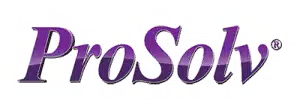Latest Articles
The advantages of using fluorinated solvents
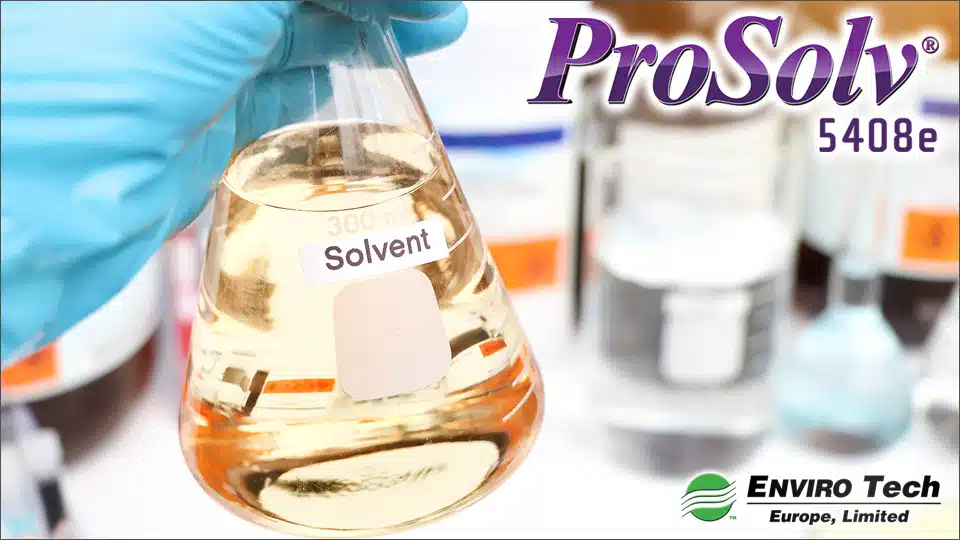
The advantages of using fluorinated solvents for your vapour degreasing process
Fluorinated solvents, also known as fluorocarbon solvents, offer several advantages in various industrial and scientific applications, including being highly suited for vapour degreasing. Here are some of the key advantages of using fluorinated solvents:
Environmental Compatibility:
Fluorinated solvents are often chosen as alternatives to more hazardous solvents due to their relatively low impact on the environment. They have low ozone depletion potential (ODP) and negligible global warming potential (GWP). Additionally, they have low toxicity and are not classified as hazardous air pollutants (HAPs).
Chemical Stability:
Fluorinated solvents exhibit excellent chemical stability, making them highly resistant to degradation and reactions with other chemicals. They are compatible with a wide range of materials, including metals, plastics, and elastomers. This stability allows for their use in challenging environments and with reactive substances.
Solvency Power:
Fluorinated solvents have strong solvency power, meaning they can dissolve a wide range of organic and inorganic compounds. This property makes them effective in applications such as cleaning, degreasing, and precision cleaning, where the complete removal of contaminants is crucial, such as cleaning to oxygen standard.
Nonflammability:
One of the significant advantages of fluorinated solvents is their non-flammable nature. Under testing to ASTM D 93 they will not flash and therefore do not support combustion, making them safer to use compared to many traditional solvents. This property reduces the risk of fire hazards in various industrial processes and applications.
Dielectric Properties:
Fluorinated solvents have excellent dielectric properties, making them ideal for applications that require electrical insulation and heat transfer. They are commonly used in electronic and electrical industries for tasks such as cleaning electrical components, cooling electronics, and as a dielectric fluid in transformers and capacitors.
Thermal Stability:
Fluorinated solvents can withstand a wide range of temperatures without decomposing or losing their properties. This thermal stability allows them to be used in high-temperature applications, including heat transfer fluids, lubricants, and as coolants in various industrial processes.
Surface Tension Control:
Fluorinated solvents have the ability to modify the surface tension of liquids, enabling them to spread evenly and improve wetting. This property makes them useful in applications such as coatings, adhesives, and printing, where uniform and controlled wetting is required.
Zero Ozone Depletion Potential (ODP) and very low Global Warming Potential (GWP) solvent cleaner for high performance vapour degreasing
ProSolv® 5408e has been developed to provide superior critical cleaning performance for manufacturers of electronic and electrical components. High Solvency (KB Value 98) for removal of organic residues, compatible with organic and synthetic oils and most plastics and metals.
ProSolv® 5408e is a high-performance solvent cleaner used for sustainable and future proof vapour degreasing. It has a GWP of less than 1, with a 100 year Integrated Time Horizon (ITH). Soft on the environment and safe for users, it offers improved cleaning at lower costs.
ProSolv® 5408e ticks all the boxes and is the perfect profile for a modern vapour degreasing solvent. Exceptionally low surface tension to penetrate micron sized holes and close contact surfaces. Sustainable and secure for the future. Non-carcinogenic, low boiling point, economical with energy with low solvent losses, faster production, reduced costs, easy handling.
EFFICIENT AND ECONOMICAL
- Fast precision cleaning with short cycle times.
- Can be used in any vapour degreasing equipment, lower energy consumption and lower maintenance.
- Ideal replacement for Trichloroethylene, n-Propyl Bromide, Perchloroethylene and HCFC based solvents.
- Stable with no additives, no testing required.
- Improved productivity, parts exit the machine cool, dry and spot-free with no drying required.
- Minimal non-volatile residue (>10ppm).
- High density solution, excellent for ultrasonic cleaning.
- Mid-range boiling point (46°C).
- Very low surface tension for penetration into the micron level crevices and holes, efficient cleaning in tight to reach places and complex geometries.
- Easy process monitoring with minimal effort and minimal waste generation, easy reclamation for reuse.
- High Solvency (KB Value 98) for a variety of contaminants.
- Compatible with a broad range of substrates.
SAFE FOR USERS AND THE ENVIRONMENT
- Safe for the environment, Zero Ozone Depletion Potential (ODP).
- Very low Global Warming Potential (GWP)
- GWP of less than 1, AR4 100yr Integrated Time Horizon (ITH).
- Non-hazardous for transportation.
- Non-flammable (No Flash Point).
- Not classified as a carcinogen
Listed above are some of the benefits from using ProSolv® 5408e, a sustainable degreasing solvent for precision cleaning and an economical and efficient replacement solution for cleaning systems using older legacy solvents, which are now either banned or being phased out. EnviroTech Europe have many years of experience and our experts are available to guide you through your solvent cleaner changeover procedures or to advise on equipment.
FURTHER INFORMATION
Please visit our website https://www.envirotech-europe.com/prosolv5408e for information about other uses and applications for ProSolv 5408e.
Visit www.envirotech-europe.com/applications-and-case-studies for information about uses and applications for all EnviroTech Europe products.
For more advice, please telephone us on +44 (0) 20 8281 6370 or use our website contact form.
All products are supplied and supported by EnviroTech Europe Ltd. Manufactured in the United Kingdom and available on short delivery times through our dedicated team of distributors worldwide.
Share this page:
Related Posts
General purpose industrial cleaning solvents
Clarea® general purpose industrial cleaning solvents for safe removal of dirt, oil, grease and other contaminants
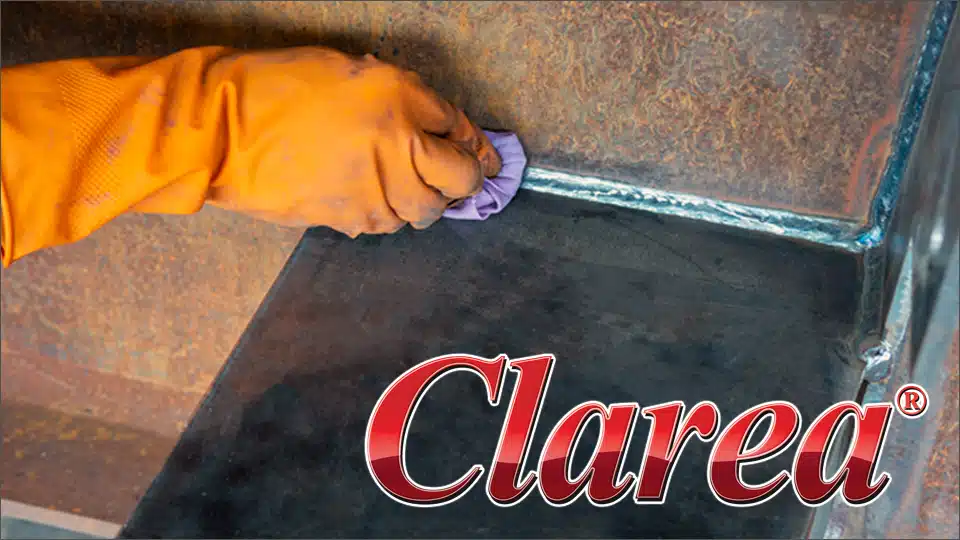
Hand or bath cleaning solvents are used in many industries to remove dirt, oil, grease, or other contaminants from machined and fabricated metal, plastic and composite surfaces. Due considerationmust be given to the effects on users and the environment. Cleaning solvents must be highly refined and leave no residues on drying. They have to be very effective in removal of oils and soils without causing damage or corrosion of the parts or components being cleaned.
Pre-used parts or assemblies from the transportation, aerospace or manufacturing equipment sectors are often very heavily contaminated when removed from service but must be free of all contaminants before handling to disassemble prior to refurbishing and rebuilding. Much of this work will be manual and the considerations for the safety of operators is paramount.
Growing concerns regarding environmental and health hazards of the commonly used chlorinated solvents for industrial degreasing and cleaning has led to the formulation of the Clarea® range of industrial cleaning solvents by EnviroTech Europe.
An environmentally safe range of hand and bath solvent cleaners
Clarea® industrial solvent cleaners are compatible with all metals, composites and most plastics used to remove dirt, oil, grease, or other contaminants from surfaces without causing harm or leavingresidue. They are used as immersion cleaners for component cleaning in manufacturing andengineering industries and as wipe cleaners for large surface areas prior to painting or powder coating. Clarea® cleaning solvents are aliphatic hydrocarbon-based degreasing solvents with specified flash points. They are non-carcinogenic, low odour, fast drying and cause no ozone depletion. They leave minimal residues on drying surfaces and contain no halogens such as chlorine or fluorine.
Clarea HC40 is a degreasing solvent with a flash point of 40°C. It is suitable for brush and hand wiping processes.
Clarea HC62 is a degreasing solvent with a flash point over 60°C. It is suitable for spray or immersion cleaning, or hand wipe applications when used externally.
Clarea HC96 is a degreasing solvent with a flash point of 96°C. It is suitable for spray or immersion cleaning.
Product Benefits
● Versatile and cost-effective solutions for all your industrial cleaning.
● Minimal odour and low toxicity for operators.
● Multipurpose uses can reduce the inventory of cleaning fluids.
● Flexible uses – evaporation rates suitable for hand wipe, spray, or immersion tank cleaning.
● Contains no chlorine, other halogens or stabilisers.
● Compatible with all metals and composites and most plastics.
● Excellent pre-cleaner for paint or powder coatings.
● Safe, reliable, environmentally friendly cleaning.
Solvent Properties
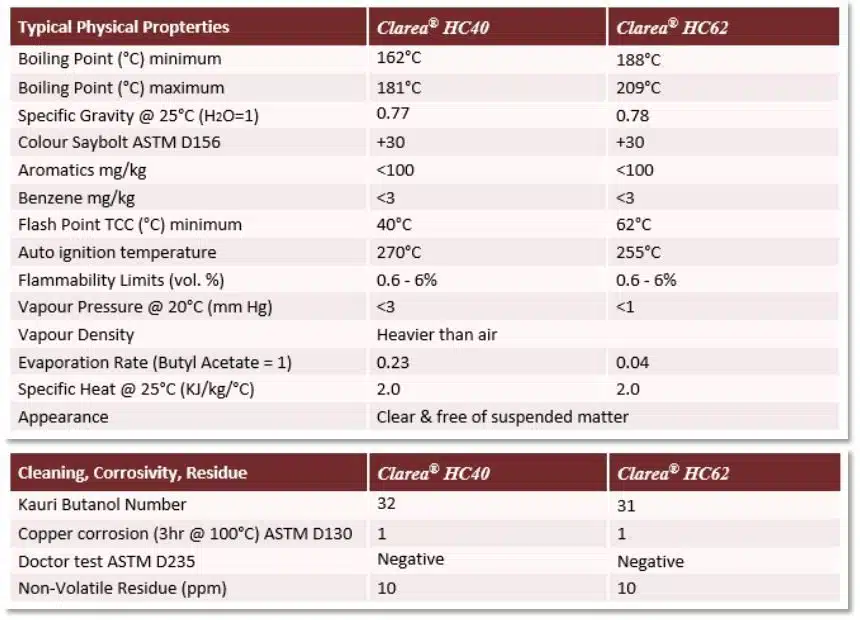
Packaging
Clarea® HC40 and Clarea® HC62 is available in the following container sizes and weights:
205 litre drums, 25 litre cans, 5 litre cans. Clarea® HC96 is available in 15kg cans and 165kg drums.
We can provide you with a Material Safety Data Sheets, independent laboratory reports, product samples and technical assistance.
For more information or advice please telephone us on +44 (0) 20 8281 6370 or use our contact form.
All products are supplied and supported by EnviroTech Europe Ltd. Manufactured in the United Kingdom and available on short delivery times through our dedicated team of distributors worldwide.
Share this page:
Related Posts
Advanced corrosion protection for automation and engineering industries
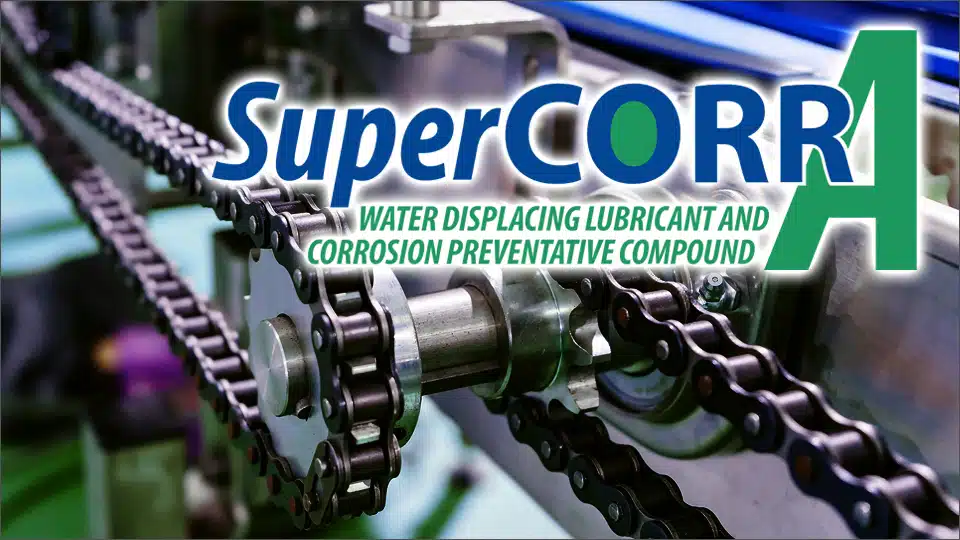
SuperCORR A – Advanced corrosion protection for automation and engineering industries
Corrosion is serious problem for industry and governments worldwide
Corrosion, in its many forms, costs both private and public sectors vast amounts of money to repair or replace mechanical, electrical and electronics components. While all metals corrode, due to various reasons, there is no simple or single solution to the overall corrosion problem. However, there are some very cost effective and proven ways to prevent corrosion and failures caused by corrosion, thereby reducing or eliminating associated costs and increasing safety, which should be of foremost importance in the mind set of any preventative maintenance programme manager.
Corrosion is an increasingly serious and costly problem that can lead to equipment failures which range from being an annoyance to being catastrophic. Failures caused by corrosion could and do lead to a direct failure of a component which could affect the entire system and can not only be very expensive in terms of down time to repair or replace but can also prove to be very costly in loss of productivity, and possibly the loss of human life.
The financial cost of corrosion accounts for between 3% to 6% of a country’s GNP [1] and a 2016 study by NACE International concluded that the annual global cost of corrosion amounts to USD 2.5 trillion [2]. These costs increase each year.
A vast amount of the annual cost of corrosion can be saved by using corrosion inhibitor products such as Super CORR A which was specifically designed to lubricate and prevent corrosion in electrical fittings and connectors, electrical harness assemblies and connectors, electrical and electronic switches, close tolerance and dissimilar metal components, lighting connectors and sockets. It is a non-flammable “self-healing” ultra-thin film lubricant with a proprietary corrosion preventive compound that will not harden or crack. is not a wax or oil-based product and is formulated without sulphates, chlorides or halogens.
Super CORR A is a unique and proprietary formulation with long-lasting, anti-corrosion inhibitors providing a superior lubrication coefficient and protection against moisture, wear, general and fretting corrosion, static electricity, corona, and other electro migration problems. The non-flammable film is only 7 microns (0.007mm) in thickness, is not a wax or oil-based product and is formulated without sulphates, chlorides, petroleum-based material, or halogens, to meet the EU RoHS directive.
Manufactured and supplied by EnviroTech Europe Ltd, it is unexcelled in preventing failures of electrical systems and electronic equipment caused by corrosion as well as preventing the corrosion of metal components surfaces. Use Super CORR A to protect connectors, electrical systems and switches and mechanical controls during servicing. It’s ability to displace water from exposed contacts can ensure reliable operation in extreme conditions, all from one small aerosol can.
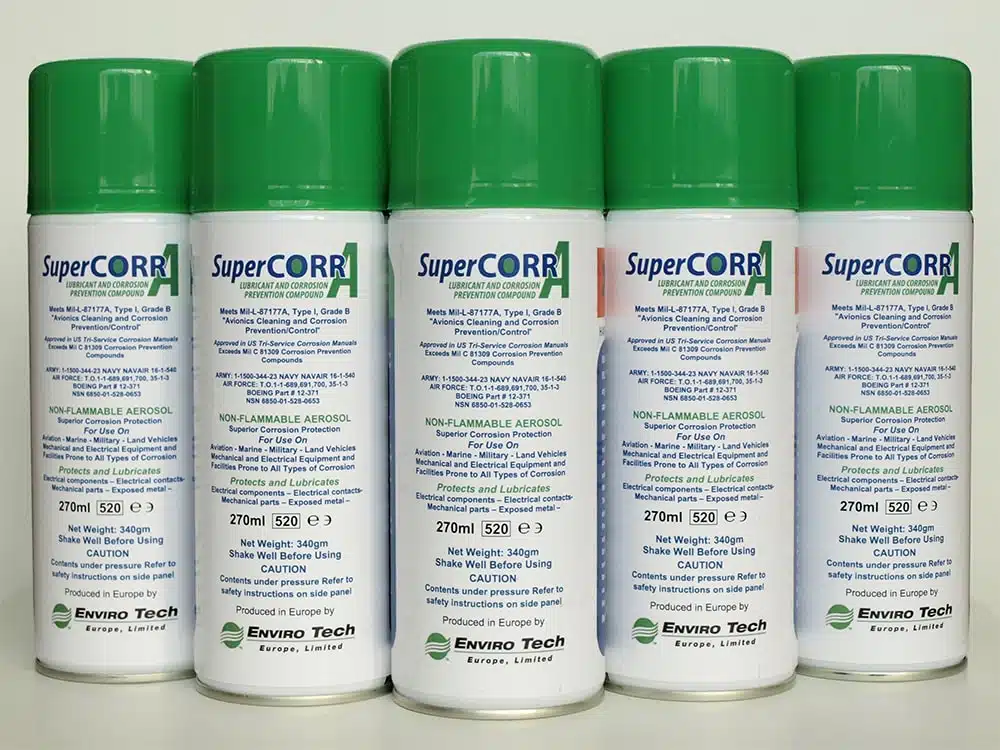
CASE STUDIES
Prevent hydrogen sulphide corrosion in electrical and electronic equipment
Electrical and electronic equipment used in adverse work environments (e.g., the oil and gas, water treatment, pulp and paper industries) where corrosive gases such as hydrogen sulphide are found, can be particularly vulnerable to corrosion and lead to the rapid deterioration of the electronic components including mechanical controls, connectors and switches. Super CORR A inhibits corrosion caused by exposure to both fresh and salt water moisture as well as the corrosive vapours from Sulphur dioxide (SO2), Nitrogen dioxide (NO2), Hydrogen Sulphide (H2S), Ammonia (NH3), and Chlorine (CL12) based gases found in waste water and sewer treatment plants, pulp and paper mills and plants, chemical and petroleum plants, maritime industry, aircraft/airline industry, military equipment including ships, aircraft, and rolling stock, auto industry, farming and agriculture industry, and the list goes on.
HFC-227ea gaseous fire suppression for electronic equipment.
When activated in a fire situation HFC-227ea will decompose to produce Hydrogen Fluoride. This is a real and ongoing concern. Why? Because Hydrogen Fluoride causes major corrosion problems for electronics and connectors. You may save your equipment but for how long?
To prevent corrosion caused by Hydrogen Fluoride, as well as other chemicals, acids, salts, and water which can be deposited during the activation of fire suppression systems or rapid humidity changes, all the electrical and electronic hardware, boards and connectors should be sprayed or coated with Super CORR A. It will protect and prevent damage to the electronics or avionics caused by exposure to the Hydrogen Fluoride produced as a by-product during the fire.
Fretting corrosion on gas turbine connectors
LP Gas Turbines are used throughout the world by extraction industries and manufacturing plants in remote and hostile locations for essential power production. Dusty and wet environments in deserts, mines, grinding mills, pulp and paper mills and on land or sea drilling rigs for gas and oil production. Turbines powering aircraft services while stationary connect and disconnect many times a day in extreme conditions. These applications and locations test connector sealing continuously allowing dust or water to penetrate. This with the flexing of the connecting cables allows sufficient movement between the metal surfaces of the connecting pins to produce fretting corrosion which reduces, interrupts or produces failures in supply. Regular maintenance of electrical connectors is essential to be certain of uninterrupted supply.
Containing extremely long-lasting, proprietary anti-corrosive inhibitors Super CORR A provides a superior lubrication coefficient and protects components against moisture, wear, general and fretting corrosion, surface static electricity, corona, and other electromigration problems.
Avionic corrosion protection
Super CORR A extends the working life of avionic harness assemblies, electrical systems and other critical items in aircraft maintenance by preventing the deterioration and/or failure caused by corrosion and can significantly reduce downtime, operating and maintenance costs as well as enhance safety. It has as undergone extensive testing by Battelle Labs as well as the U.S. Air Force and meets MIL-DTL-87177B (revised MIL-L-87177A) specification.
Super CORR A is used by NATO (NATO NSN 8030-99-226-6966) to protect avionic electrical switches, sockets, connectors and components from corrosion in both the military and civilian aircraft. It is the global industry standard for electrical corrosion protection, for in service maintenance by both military and commercial aircraft major repair and overhaul (MRO) facilities.
Sea Spray exposure
Most people associate corrosion control with rust, which only happens in things made of ferrous metals such as steel girders, ships, iron pipes, steel reinforcement rods, and steel tanks and is the reason metals deteriorate and fail. Ferrous and non-ferrous metals corrode on contact with both fresh and saltwater as well as water vapour. They will also corrode when they come into contact with chemicals, liquid acids as well as acidic vapours, salts and bases, and bacteria.
The U.S. Navy selected Super CORR A after exhaustive testing using American Society for Testing and Materials (ASTM) Standard B117- Standard Practice for Operating Salt Spray Apparatus.
Super CORR A out-performed 11 other products in comparative testing to identify a better product to protect and lubricate the flap tracks and screw jacks on the aircraft. Super CORR A was evaluated against competitive products under the Federal Test Method Standard #791B, using a five percent Salt Spray Corrosion Test.
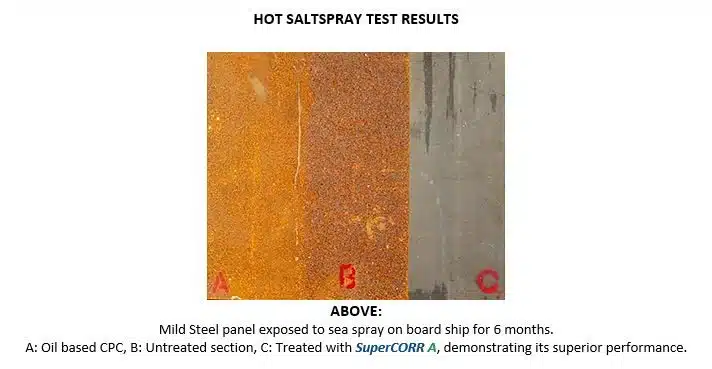
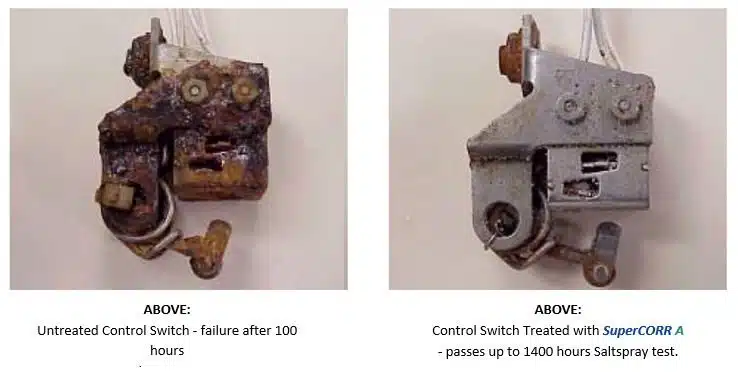
The use of Super CORR A in regular maintenance procedures can bring financial savings in reduced maintenance and replacement costs, and more importantly, greater safety.
Maintenance of contacts on portable gas generators
A leading manufacturer of connectors tested Super CORR A to see what the “life” of the lubricant was in a “rub test”. The typical test is 20,000 cycles, i.e. unplug, plug in is one cycle. The test results demonstrated that after 20,000 cycles there were no failures. It was decided to take it one more step and run the same tests for 200,000 cycles. The results again showed no indications of galling or scoring on the connectors at all. The connector looked and tested as good as new. This test was run under clean conditions in a laboratory but demonstrates the effectiveness of the protective lubricant in Super CORR A.
Unpainted metal in highly corrosive environments
Tests demonstrate the amazing properties of Super CORR A corrosion protection spray to protect unpainted metal surfaces from corrosion. These are photographs of 3 unpainted copper components that were exposed for a month next to the “digester” at a Pulp and Paper Mill.
The main atmospheric corrosion was from hydrogen sulphide (H2S) gas, produced during the cellulose digestion process, which combines with the atmospheric humidity to form a mild acid. Any unpainted or untreated metal surface, copper, brass, mild steel or alloys of zinc and manganese or magnesium will be corroded by this acid when it condenses on the metal surfaces.
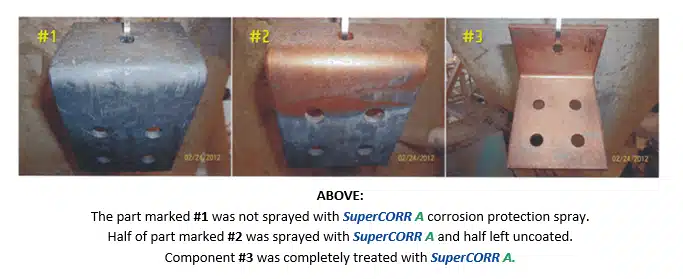
Tests demonstrate the amazing properties of Super CORR A to protect unpainted surfaces from acidic corrosion. As an example, copper and aluminium condensers on water coolers usually last about a month in the acidic environment of pulp production facilities because the corrosive atmosphere around the plant corrodes the metal surfaces on fins and connections.
Super CORR A has been also used to protect contacts on the Lifedge lightning connector to USB cable to offer the protection needed in extreme conditions. During the design of this new cable an extensive test programme was carried out by Scanstrut to ensure the contacts were protected from corrosion in the salty and hostile environments in which the connectors are used.
CONCLUSION
It is clear the use of Super CORR A for corrosion control can not only bring financial savings in reduced maintenance and replacement costs but more importantly greater safety. It is much simpler and a lot less costly to prevent corrosion than to repair or replace the damaged equipment or component that failed because of corrosion. As you have seen The photographs show the effects of protecting metal surfaces and components in extreme condition with Super CORR A.
Super CORR A is packaged in aerosol cans making access to component parts easy for engineering crews in difficult locations and conditions. Unpainted mild steel will not rust on exterior surfaces directly exposed to sea water environments for at least 6 months, protecting electrical connectors, switches, chains, drive shafts from corrosion while maintaining lubrication on moving surfaces.
EFFICIENT AND ECONOMICAL
- Extremely long-lasting, specially formulated and proprietary anti-corrosive inhibitor.
- Eliminates premature failure of components created by moisture, general or fretting corrosion.
- Prevents deterioration and contamination on all surfaces of electronic and electrical equipment and mechanical close tolerance moving components.
- Reliability increased, maintenance intervals increased and costs reduced, manufacturers save costly warranty service calls or product re-call.
APPROVED
- Industry approval from: NASA, Boeing Aircraft, Bombardier, Embraer, Lear, Gulfstream, Hawker-Beechcraft, Cessna, Raytheon, Polish Airforce, Northrop-Grumman, Royal Navy and Royal Norwegian Air Force.
- Exceeds Mil C 81309 Corrosion Prevention Compounds.
- Approved in US Tri-Service Corrosion Manuals.
References
[1] https://heat-exchanger-world.com/featured-story-the-cost-of-corrosion-microbial-corrosion-in-heat-exchange
[2] http://impact.nace.org/economic-impact.aspx
FURTHER INFORMATION
Please visit our website https://www.envirotech-europe.com/supercorr-a for for information about other uses and applications for Super CORR A.
Visit www.envirotech-europe.com/applications-and-case-studies for information about uses and applications for all EnviroTech Europe products.
For more advice, please telephone us on +44 (0) 20 8281 6370 or use our website contact form. All products are supplied and supported by EnviroTech Europe Ltd. Manufactured in the United Kingdom and available on short delivery times through our dedicated team of distributors worldwide.
Share this page:
Latest News
Reduce Corrosion Fretting
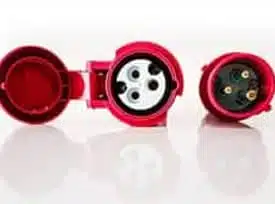
Why use of SuperCORR A for maintenance of electrical connections on Gas Turbines improves performance by reducing corrosion fretting.
LP Gas Turbines are used throughout the world by extraction industries and manufacturing plants in remote and hostile locations for essential power production. Dusty and wet environments in deserts, mines, grinding mills, pulp and paper mills and on land or sea drilling rigs for gas and oil production. Turbines powering aircraft services while stationary connect and disconnect many times a day in extreme conditions. These applications and locations test connector sealing continuously allowing dust or water to penetrate. This with the flexing of the connecting cables allows sufficient movement between the metal surfaces of the connecting pins to produce fretting corrosion which reduces, interrupts or produces failures in supply.
Regular maintenance of electrical connectors is essential to be certain of uninterrupted supply.
SuperCORR A is an aerosol lubricant containing corrosion preventive compounds, and, as is the case with all lubricants, they can be worn off over time. A manufacturer of connectors tested SuperCORR A to see what the “life” of the lubricant was in a “rub test”. The typical test is 20,000 cycles, i.e. unplug, plug in is one cycle. The test results demonstrated that after 20,000 cycles there were no failures. It was decided to take it one more step and run the same tests for 200,000 cycles. The results again showed no indications of galling or scoring on the connectors at all. The connector looked and tested as good as new. This test
was run under clean conditions in a laboratory but demonstrates the effectiveness of the protective lubricant in SuperCORR A.
As it meets Mil-DLT-87177B specifications it is used by the U.S. Air Force to protect the intricate workings of the F-16 and F-15 fighter jets and by the U.S. Navy on the P 3 Orion electronic surveillance aircraft. Savings for the U.S. government is estimated at $50 million per year. Commercial Aviation aircraft manufacturers recommend it for avionics and electrical switches and connectors and close mechanical application, especially where flights are in salt fog or high humidity.
Containing extremely long-lasting, proprietary anti-corrosive inhibitors SuperCORR A provides a superior lubrication coefficient and protects components against moisture, wear, general and fretting corrosion, surface static electricity, corona, and other electro migration problems. The super thin non-flammable lubricant film is only 7 microns (0.0007 inch) thick and is formulated without sulphates, chlorides or halogens to meet the RoHS directive. It is unexcelled in preventing deterioration and contamination on all surfaces of electronic equipment.
Very fast drying environmentally acceptable solvents are used as carriers and propellants which will not affect most plastics, substrates, metals or other materials used in connector manufacture. The aerosols are supplied with probes which allow access to pins and connector tubes where the low surface tension repels water, dirt dust and metal particles from blind holes and surfaces to produce thoroughly clean holes and surfaces before a second application applies the lubricant film. Reconnection to the supply with cleaned sections of the connector ensures reliable operation even in the most testing of environments. This easy maintenance from one can of SuperCORR A allows this essential task to be carried out in any conditions quickly, easily and securely.
We can provide you with a Material Safety Data Sheets, independent laboratory reports, product samples and technical assistance.
For more information or advice please telephone us on +44 (0) 20 8281 6370 or use our contact form.
All products are supplied and supported by EnviroTech Europe Ltd. Manufactured in the United Kingdom and available on short delivery times through our dedicated team of distributors worldwide.
Share this page:
Related Posts
Managing “false alarms” and “no fault found” events in Military avionic systems.
Paper presented at the recent 2017 Aviation Electronics Europe Expo in Munich by Dr. Mustafa Ilarslan, PhD.
In a paper presented at the recent 2017 Aviation Electronics Europe Expo in Munich, Germany, Dr. Mustafa Ilarslan, PhD, discussed – “The management of “False Alarms” and “No Fault Found” events in Military avionic systems”.
In his paper Dr. Ilarslan explains that “False alarms (FAs) impose a devastating impact on military systems. An entire aircraft can be grounded because of a single avionics for which there are insufficient spares available. If a FA causes a particular Line Replaceable Unit (LRU) to be called out incorrectly, there is a better than even probability that a second copy of the same LRU will also experience FA and much sooner than expected, the fleet will be deprived of all spares for that LRU. To then find that the LRUs replaced had No Fault Found (NFF) at the repair depot adds “salt to the wound.” while adding huge sums for lost time in servicing, aircraft downtime and unnecessarily high stocks of replacement parts.
SuperCORR A was designed specifically to prevent these problems in avionic as well as electrical and electronic components and systems failures caused by corrosion, including no fault found failures and problems caused by Cadmium corrosion. SuperCORR A is a proprietary Ultra-Thin Film, Water Displacing Lubricant and Corrosion Preventative Compound, manufactured under license in the UK by EnviroTech Europe Ltd.
SuperCORR A is being used on both military and civilian aircraft to prevent fretting corrosion on electronic and electrical connectors, including F-16, P-3 Orion, Boeing 737’s, C-130, F-15, DHC-6 Twin Otter, Bell helicopters, Bombardier BD-700 series and Bombardier Challenger 300/350, Learjet 45, Legacy 650, and Hawker to name but a few.
SuperCORR A is also being used at BAE Systems, Honeywell and Raytheon Systems to prevent corrosion from causing avionic, electronics, and electrical systems and components failures and for lubrication and protection of moving parts with a thin dry film.
SuperCORR A meets the requirements of MIL-L-87177A and Mil-DTL-87177B.
More detailed information can be found in the paper “Electrical connector corrosion prevention Improves reliability and reduces costs” by David Horne which is available here:
NOTE that while quoting Dr. Ilarslam’s paper, with his permission, he is not endorsing or recommending the use of any specific product, including SuperCORR A.
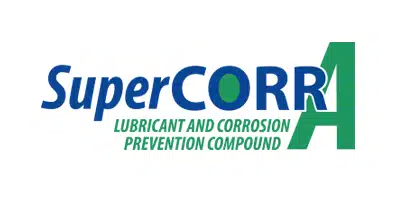
We can provide you with a Material Safety Data Sheets, independent laboratory reports, product samples and technical assistance.
For more information or advice please telephone us on +44 (0) 20 8281 6370 or use our contact form.
All products are supplied and supported by EnviroTech Europe Ltd. Manufactured in the United Kingdom and available on short delivery times through our dedicated team of distributors worldwide.
Share this page:
Related Posts
Vapour Degreasing Solvents For Precision Metal Cleaning
CONTENT ON THIS PAGE IS RETAINED FOR INFORMATION ONLY
DUE TO n-Propyl bromide now being included in Annex 14 of REACH
EnviroTech Europe Ltd (ETE) continue to publish it as historical information and to record changes occurring in legislation which have affected decisions on formulations and equipment used in vapour degreasing - the most effective, quickest, flexible and cheapest cleaning system used in industry.
EnSolv® invented and patented by EnviroTech has been a market leader all over the world for vapour degreasing. It is based on n-bromopropane (nPB) which now cannot be used as a vapour degreaser within the UK or EU without authorisation.
Archived information about EnSolv® can be found using the Discontinued Products & Resources navigation menu on this page.
Using experience accumulated over 40 years supplying and supporting users of the vapour degreasing process ETE specialists have developed “drop in” alternatives:
ProSolv®, ProSolv5408e® and EnSolv CC-A® give the same or improved level of performance and economy as the original EnSolv® products.
Please contact our advisers who are available to discuss your needs and propose the best replacement product.
Or please click here to return to our vapour degreasing products homepage for information about our current products.

Environmentally friendly precision vapour degreasing and cleaning solvents for the aerospace, precision engineering, medical, optical and electronic industries.
EnSolv vapour degreasing solvents are the most effective alternative to trichloroethylene and other chlorinated and fluorocarbon based solvents. Fast, economical cleaning and degreasing in one tank using minimal floor area.
EnSolv degreasing solvents are specifically formulated to address the difficult precision cleaning problems experienced in high-tech industries where exceptional levels of cleanliness are needed.
EnSolv is a trusted family of environmentally friendly precision vapour degreasing and cleaning solvents for the aerospace, precision engineering, medical, optical and electronic industries. Custom blends serve applications where standard formulations require modifications.
These degreasing solvents are specifically formulated to address the difficult cleaning problems experienced in industries where exceptional levels of precision cleaning are needed.
The EnSolv range of solvents are economical in use, with very high solvency power for excellent fast precision cleaning in any vapour degreasing equipment with greatly improved productivity and lower maintenance costs. Mid range operating temperature reduces energy usage with a faster cleaning cycle and easier more comfortable handling for operators.
EnSolv is safe for the environment with low global warming and ozone depletion the lower temperature of operation reduces energy usage and reduces CO2 emission. EnSolv® is not classified as a carcinogen enhancing safe usage for operators
EnSolv is approved by US EPA Snap and is included in US Tri- Service corrosion manuals. Usage is Approved by Boeing and the major OEMs worldwide as a replacement for trichloroethylene.
Manufactured in the UK with excellent customer service, technical support and training from qualified distributors throughout Europe.
We can provide you with a Material Safety Data Sheets, independent laboratory reports, product samples and technical assistance.
For more information or advice please telephone us on +44 (0) 20 8281 6370 or use our contact form.
All products are supplied and supported by EnviroTech Europe Ltd. Manufactured in the United Kingdom and available on short delivery times through our dedicated team of distributors worldwide.
Share this page:
Related Posts
Industrial Degreasing Solvents – Safe For The Environment
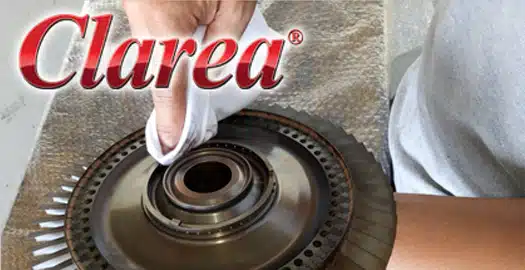
Eco Friendly Industrial Degreasing Solvents, Safe For Users And The Environment.
Cleaning agents are used in many industries to remove dirt, oil, grease, or other contaminants from machined and fabricated metal, plastic and composite surfaces.
The solvents must be highly refined and leave no residues on drying. They have to be very effective in removal of oils and soils without causing harm to the parts or components being cleaned and leave minimal residues. Solvents are used for cleaning using spray washers or immersion tanks with or without ultrasonics or agitation in manufacturing or automotive industries for removal of process oils from manufacturing processes .
Pre-used parts or assemblies from the transportation, aerospace or manufacturing equipment sectors are often very heavily contaminated when removed from service but must be free of these oils, soils, grease, dirt and contaminants before handling to disassemble prior to refurbishing and rebuilding.
A growing concern regarding environmental and health hazards of the most commonly used chlorinated solvents as industrial degreasing agents has led to the formulation by EnviroTech Surface Technologies of the Clarea® range of safer cleaning solvents.
Clarea solvents can be used for spray or immersion cleaning for very heavy soiling or are used as wipe cleaners for large surface areas prior to painting or powder coating.
Why should you choose Clarea industrial cleaning solvents.
The solvents applied during production or finishing processes have a direct effect on the health of workers and the environment.
Volatile organic compounds or VOCs are chemicals which vaporise at room temperatures. Traditional solvents used for cleaning have low boiling points and a high VOCs making them harmful to use and less eco-friendly Exposure to the VOC’s released by these cleaning agents must be controlled to prevent respiratory, allergic, and immune system complications for users. If your company uses industrial degreasing agents regularly, it is time to evaluate the dangers of this choice.
Clarea is a less volatile alternative than conventional cleaners. Highly refined aliphatic hydrocarbons with minimal residues and tight vaporisation ranges are capable of providing the same results and can be substituted to create a safer, sustainable, eco-friendly workplace.
The low odour, low flammability and low toxicity of Clarea® solvents provides performance and operator and environmental acceptability using less material at lower costs. Multipurpose use can reduce the inventory of cleaning fluids stocked.
Clareaa HC40 for brush and hand wiping, air dries. Flash point 40℃.
Clarea HC62 for dip cleaning with agitation or ultrasonics.
Low evaporation. Non-flammable.
Clarea® range of solvents is supplied through our distributors worldwide.
Other solvents in our cleaning specialities range are:
ProSolv 5408e: Precision solvent for electronics, medical and other critical cleaning applications.
Aquus CL-One: Water based neutral cleaners for use where solvents are not compatible with substrates.
We can provide you with a Material Safety Data Sheets, independent laboratory reports, product samples and technical assistance.
For more information or advice please telephone us on +44 (0) 20 8281 6370 or use our contact form.
All products are supplied and supported by EnviroTech Europe Ltd. Manufactured in the United Kingdom and available on short delivery times through our dedicated team of distributors worldwide.
Share this page:
Preventing hydrogen sulphide corrosion in electrical and electronic equipment

A Cost Effective and Proven Corrosion Preventative Solution.
By Larry Clark, EnviroTech Europe Ltd
Electrical and electronic equipment and components that are used in adverse work environments, e.g. the oil and gas industry, waste water treatment plants, and the pulp and paper industry, where corrosive gases such as hydrogen sulphide are found cause severe corrosion and the rapid deterioration of the electronic components and equipment including connectors and switches used in these and other work environments. One economical way to prevent or inhibit corrosion from destroying electronics and electrical components is to use SuperCORR A, Ultra Thin Film, Water Displacing, Lubricant and Corrosion Inhibiting Compound.
If you or your company aren’t worried about costs then by default you aren’t concerned about corrosion or it’s associated costs in lost productivity and lost revenue caused by plant and equipment down time then this a paper that you should just skip. But if you and your company are concerned about costs including the amount money and man hours to repair or replace components to keep an electrical system or electronics operating, an aircraft flying, or a machine running because of failures caused by corrosion then this paper is for you!
Corrosion, in its many forms, is costing both private and public sector hundreds of billions of Euros a year! While all metals corrode due to a number of different factors there is no simple or single solution to the overall corrosion problem. However there are some very cost effective and proven ways to prevent corrosion and failures caused by corrosion and thereby reducing or eliminating associated costs and increasing safety which should be foremost in the mind set of any Preventative Maintenance Programme manager.
One proven and cost effective solution to the corrosion problem is SuperCORR A, a water displacing, ultra thin film lubricant with corrosion preventative properties. SuperCORR A was designed specifically to lubricate and prevent corrosion in electrical fittings and connectors; electrical and avionic harness assemblies and connectors; electrical and electronic switches; close tolerance and dissimilar metal components; lighting connectors and sockets; and the list goes on and on.
SuperCORR A is a unique non-flammable “self healing” ultra thin film lubricant with a proprietary corrosion preventive compound that will not harden or crack. SuperCORR A is not a wax or oil based product and is formulated without sulphates, chlorides or halogens.
SuperCORR A inhibits corrosion caused by exposure to both fresh and salt water moisture as well as the corrosive vapours from Sulphur dioxide (SO2), Nitrogen dioxide (NO2), Hydrogen Sulphide (H2S), Ammonia (NH3), and Chlorine (CL12) based gases found in waste water and sewer treatment plants, pulp and paper mills and plants, chemical and petroleum plants, maritime industry, aircraft/airline industry, military equipment including ships, aircraft, and rolling stock, auto industry, farming and agriculture industry, and the list goes on. Extending the working life of electrical components and systems and other critical items by preventing the deterioration and/or failure caused by corrosion can significantly reduce downtime and operating and maintenance costs as well as enhance safety.
The question for you is: What is the cost of NOT using SuperCORR A in your Preventative Maintenance Programme?
SuperCORR A is available from EnviroTech Europe Ltd and our distributors worldwide.
We can provide you with a Material Safety Data Sheets, independent laboratory reports, product samples and technical assistance.
For more information or advice please telephone us on +44 (0) 20 8281 6370 or use our contact form.
All products are supplied and supported by EnviroTech Europe Ltd. Manufactured in the United Kingdom and available on short delivery times through our dedicated team of distributors worldwide.
Share this page:
Trichloroethylene a known human carcinogen
CONTENT ON THIS PAGE IS RETAINED FOR INFORMATION ONLY
DUE TO n-Propyl bromide now being included in Annex 14 of REACH
EnviroTech Europe Ltd (ETE) continue to publish it as historical information and to record changes occurring in legislation which have affected decisions on formulations and equipment used in vapour degreasing - the most effective, quickest, flexible and cheapest cleaning system used in industry.
EnSolv® invented and patented by EnviroTech has been a market leader all over the world for vapour degreasing. It is based on n-bromopropane (nPB) which now cannot be used as a vapour degreaser within the UK or EU without authorisation.
Archived information about EnSolv® can be found using the Discontinued Products & Resources navigation menu on this page.
Using experience accumulated over 40 years supplying and supporting users of the vapour degreasing process ETE specialists have developed “drop in” alternatives:
ProSolv®, ProSolv5408e® and EnSolv CC-A® give the same or improved level of performance and economy as the original EnSolv® products.
Please contact our advisers who are available to discuss your needs and propose the best replacement product.
Or please click here to return to our vapour degreasing products homepage for information about our current products.
Trichloroethylene formally listed as a “Known Human Carcinogen”.
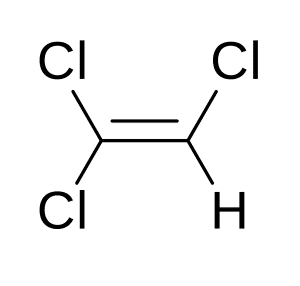 |
After many years of being listed as a possible or probable human carcinogen, the widely used solvent trichloroethylene (TCE) has now been listed by the National Toxicology Program (NTP) of the U.S. Department of Health and Human Services as a “known human carcinogen.” Ref; NTP’s 14th Report on Carcinogens (November 3, 2016).
Trichloroethylene is widely used in manufacturing industries as a vapour degreasing solvent but its principal uses are as an intermediate raw material in hydrofluorocarbon chemical manufacture. In the light of a number of human studies showing a causal connection between TCE exposure and an increased risk of kidney cancer, NTP re-evaluated and ultimately reclassified TCE. In addition to cancer risk, other problems that have been attributed to TCE exposure include immunotoxicity, neurotoxicity, reproductive toxicity and developmental toxicity, such as potential fetal cardiac defects.
As a known carcinogen exposure to TCE is highly regulated already in the European Union. From April 2016 its use has required authorisation for specified applications.
The ban on the use of TCE for vapour degreasing, a very widely used cleaning process, causes many problems in the engineering and manufacturing industries where oil and soils need to be removed between stages in the production processes and on finished products. The use of alternative water based cleaners are inconvenient and increase process times and costs.
A safer alternative, EnSolv is available as an established “drop in” replacement for TCE often using existing vapour degreasing equipment. For more information on conversion, help or advice from EnviroTech Europe Specialist team go to www.vapour-degreasing.com.
We can provide you with a Material Safety Data Sheets, independent laboratory reports, product samples and technical assistance.
For more information or advice please telephone us on +44 (0) 20 8281 6370 or use our contact form.
All products are supplied and supported by EnviroTech Europe Ltd. Manufactured in the United Kingdom and available on short delivery times through our dedicated team of distributors worldwide.
Share this page:
Lubricant And Corrosion Inhibitors

How SuperCORR A protective lubricant prevents seizures of automatic handling systems in the harsh conditions of Industrial cleaning systems.
Specialist cleaning equipment manufacturer C&C Hydrosonics a division of U.S giant Crest Ultrasonics have solved a problem with seizures occurring the on x-y axis linear tracks on their automatic handling systems fitted to multi tank cleaning systems both aqueous and solvent based.
The automatic handling systems are programmed to process baskets or jigs through a cleaning cycle transferring between tanks, lowering and raising work from the liquids. The motorised carriages use nylon wheels running on case hardened mild steel tracks (stainless steel is not available) which corrode in the chemical atmospheres in the machine canopies.
The corrosion prevents smooth running with wheels seizing and binding on the tracks. The vibration can cause components to be shaken from jigs or in extreme cases the carriage will stall requiring intervention by service engineers to remove corrosion and re-lubricate tracks with oil. This is a temporary measure as the oil is quickly removed by the solvents and water based cleaning solutions with corrosion recurring in a short time.
SuperCORR A from EnviroTech Europe is an innovative dry lubricant formulation with protective properties which forms a self-healing film applied from an aerosol. The inorganic lubricant is unaffected by water and acts a barrier against rusting and corrosion. Extensive Trials by C&C Hydrosonics over a six month period with both solvent and water based systems demonstrated that SuperCORR A offered a simple solution to the problem with no seizures during the trial period. Previously maintenance every six weeks was needed, now an aerosol spray of SuperCORR A is used only during service visits as a routine lubrication and applied during production of the handling system.
Lee Casey Managing Director of C&C is delighted with the cost savings on reduced service and maintenance calls using SuperCORR A but is even more pleased that the inconvenience to customers has been eliminated. Use of SuperCORR A has now been extended worldwide on Crest automated handling systems.
SuperCORR A is available from EnviroTech Europe Ltd and distributors worldwide.
We can provide you with a Material Safety Data Sheets, independent laboratory reports, product samples and technical assistance.
For more information or advice please telephone us on +44 (0) 20 8281 6370 or use our contact form.
All products are supplied and supported by EnviroTech Europe Ltd. Manufactured in the United Kingdom and available on short delivery times through our dedicated team of distributors worldwide.
Share this page:
The only realistic “drop in” replacement for TRIKE.
CONTENT ON THIS PAGE IS RETAINED FOR INFORMATION ONLY
DUE TO n-Propyl bromide now being included in Annex 14 of REACH
EnviroTech Europe Ltd (ETE) continue to publish it as historical information and to record changes occurring in legislation which have affected decisions on formulations and equipment used in vapour degreasing - the most effective, quickest, flexible and cheapest cleaning system used in industry.
EnSolv® invented and patented by EnviroTech has been a market leader all over the world for vapour degreasing. It is based on n-bromopropane (nPB) which now cannot be used as a vapour degreaser within the UK or EU without authorisation.
Archived information about EnSolv® can be found using the Discontinued Products & Resources navigation menu on this page.
Using experience accumulated over 40 years supplying and supporting users of the vapour degreasing process ETE specialists have developed “drop in” alternatives:
ProSolv®, ProSolv5408e® and EnSolv CC-A® give the same or improved level of performance and economy as the original EnSolv® products.
Please contact our advisers who are available to discuss your needs and propose the best replacement product.
Or please click here to return to our vapour degreasing products homepage for information about our current products.
|
|
Why EnSolv is the only realistic “drop in” replacement for TRIKE as a Vapour Degreasing Solvent.
Syd Treacher, a Surface Cleaning Consultant discusses the current controversy regarding replacements for trichloroethylene, the most commonly used vapour degreasing solvent, which was to be phased out of use in industrial applications in April 2016.
This article was prompted while reading an article where the author claimed that a grade of fluorocarbon solvent was a “drop in” replacement for TRIKE (trichloroethylene) and n- propyl bromide. This statement is not true for the majority of applications for which trichloroethylene is used – vapour degreasing or more correctly condensation cleaning.
As a consultant in surface cleaning technology I have studied the options available and come to the conclusion that the stabilised n-propyl bromide (nPB) sold in the UK under the brand name EnSolv® is the ONLY realistic “drop in” replacement for trichloroethylene when used for vapour degreasing. It is on average up to 50% cheaper than fluorocarbon formulations being proposed as alternatives.
From my evaluation it is clear current users of EnSolv® can continue to use the solvent and equipment or if still if using TRIKE you can make the change to EnSolv® in a day. A decision has to be made quickly as the “sunset date” after which TRIKE will not be available for industrial use without authorisation in the EU was April 2016 but you can substitute with only minor changes to control settings on equipment. The legislation regarding the use of nPB may change in the future but if this happens you will have at least 3 years to decide on the alternative so the savings in solvent costs over this period will be considerable compared to alternative materials. Read the full article here.
We can provide you with a Material Safety Data Sheets, independent laboratory reports, product samples and technical assistance.
For more information or advice please telephone us on +44 (0) 20 8281 6370 or use our contact form.
All products are supplied and supported by EnviroTech Europe Ltd. Manufactured in the United Kingdom and available on short delivery times through our dedicated team of distributors worldwide.
Share this page:

